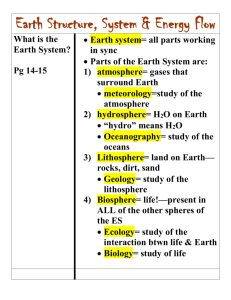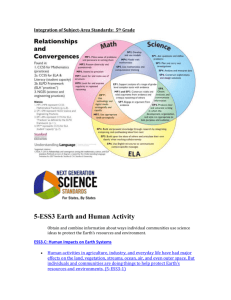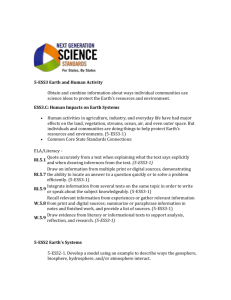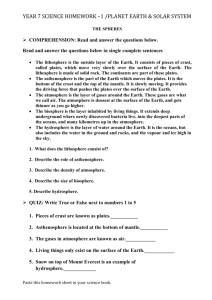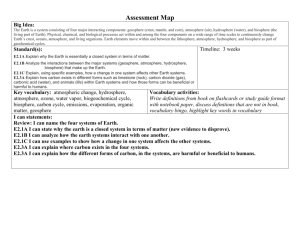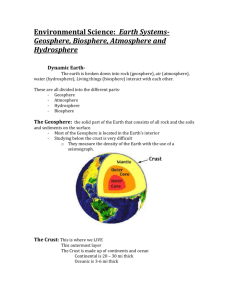Volcanoes and Igneous Activity Earth
advertisement
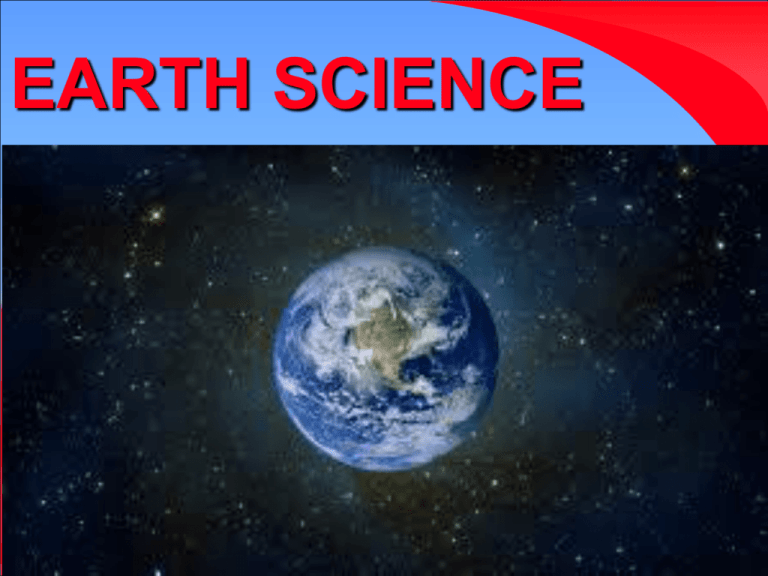
EARTH SCIENCE Chapter 1 Introduction to Earth Science 1.1 What Is Earth Science? Overview of Earth Science Encompasses all sciences that seek to understand • Earth • Earth's neighbors in space http://www.coexploration.org/geoscienceliteracy/Images/earth_science_literacy_framework12_600px.jpg http://thespuds.files.wordpress.com/2012/05/earth-science.jpg Branches of Earth Science Because one person cannot keep up with the development in all areas of earth science, most earth scientists today specialize in one of the following four major areas of study: • Geology • Oceanography • Meteorology • Astronomy Geology Geology – The study of the origin, history and structure of the solid earth and the processes that shape the earth Explore the earth’s crust in search of new deposits of coal, oil, gas, and other valuable resources. Study the forces within the earth in order to better understand earthquakes and volcanic eruptions. Study fossils to learn more about the earth’s past Earth Science: Study of the earth, its history, its changes and its place in the universe Branches of Earth science: Geology- study of the earth’s origin, history and structure •physical- materials that make up earth and the processes that shape earth’s surface •historical-earth’s history Oceanography Oceanography – The study of the earth’s oceans. Oceans cover nearly three-fourth’s of the earth’s surface. Work on research ships equipped with special instruments to study the sea. Study waves, tides, and ocean currents. Explore the ocean floor for clues to the earth’s history and to locate mineral deposits. Study marine plant and animal life Meteorology Meteorology - The study of the earth’s atmosphere. •Meteorologists use satellites, radar, and other modern technology. •Study the variations in atmospheric conditions that produce weather. •Observe weather, measuring wind speed, temperature and rainfall. Information is used to make weather maps •Use weather maps, satellite images, and computer data to make weather forecasts Astronomy Astronomy – The study of the universe beyond the earth. One of the oldest branches of earth science. Ancient Babylonians charted the planets and stars nearly 4000 yrs. ago. Modern astronomers use earth and space based telescopes and other instruments to study the universe. Space probes, such as , Pioneer, Voyager, Galileo, and Ulysses have provided much useful data. • Meteorology- study of the earth’s atmosphere, weather and climate • Oceanography- study of the earth’s oceans, including their physical features, life forms and natural resources • Astronomy- study of the universe • Hydrology- study of earth’s water Ecology Earth Scientists primarily study the: Geosphere – The solid earth Hydrosphere - The earth’s water Atmosphere – The gases surrounding the earth Ecology • Another area of science in which earth science and biology are closely linked is Ecology. “Eco” comes from the Greek word “oikos”meaning house. • Ecology – The study of relationships between living things and their environment. • Ecosystem means the environment a community of organisms inhabit. The largest ecosystem is called the biosphere. • The Biosphere encompasses all life an earth and the physical environment that supports it. It extends from the ocean depths to the atmosphere a few kilometers above the earths surface. The Importance of Earth Science Understanding how natural forces shape our environment can help better forecast potential disasters. Studying distant galaxies has led to theories about the origins of this solar system. Clues found by studying rock have provided information about the earth’s past. The earth provides resources that enrich our lives. Fuel Metal Paper and Ink • The Earth is continually changing – sometimes rapidly – like with tornadoes, earthquakes, tsunamis- but, many changes occur so gradually that they go unnoticed in a lifetime. Formation of Earth Most researchers conclude that Earth and the other planets formed at essentially the same time. Nebular Hypothesis • The solar system evolved from an enormous rotating cloud called the solar nebula. A B C D E •Nebular Hypothesis Enormous rotating cloud made up mostly of hydrogen and helium, with a small percentage of heavier elements created Solar System Inner planets were not able to hold the lighter gases - hydrogen and helium. They were pulled toward heavier planets. Earth, Mars and Venus retained heavier gases including water vapor and carbon dioxide Outer planets contain high percentages of water, carbon dioxide, ammonia and methane – Size and frigid temperatures of outer planets provided surface gravity to hold heavier gases. Layers Form on Earth Decay of radioactive elements and heat of colliding particles caused interior to melt Denser materials (Fe & Ni) sank to center Lighter, rocky material floated to surface. Sinking and floating still believed to be occurring on a smaller scale Interior is not made up of uniform materials –layers have different properties Gaseous materials escaped – atmosphere formed along with the ocean. Composed mainly of gases released from within the planet. 1.2 A View of Earth Earth's Major Spheres 1. Hydrosphere • Ocean is the most prominent feature of the hydrosphere. - Is nearly 71% of Earth's surface - Holds about 97% of Earth's water • Also includes fresh water found in streams, lakes, and glaciers, as well as that found underground Earth’s physical environment divided into 4 major spheres • Hydrosphere – water portion – All water on Earth – What makes Earth unique – Water continually moves – evaporating and then returning as precipitation – 97% of H2O in Oceans – 3% is Fresh H2O 1.2 A View of Earth Earth's Major Spheres 2. Atmosphere • Thin, tenuous blanket of air • One half lies below 5.6 kilometers (3.5 miles) 3. Biosphere • Includes all life • Concentrated near the surface in a zone that extends from the ocean floor upward for several kilometers into the atmosphere • Atmosphere – gaseous envelope –Extends 100km above the Earth –90% is within 16km of Earth –Provides air we breath –Protects from sun’s intense heat and radiation –Produce weather and climate • http://www.youtube.com/watch?v=fyfN9t_ E0w8 1.2 A View of Earth Earth's Major Spheres 4. Geosphere • Based on compositional differences, it consists of the crust, mantle, and core. - Crust—the thin, rocky outer layer of Earth. - Mantle—the 2890-kilometer-thick layer of Earth located below the crust. - Core—the innermost layer of Earth, located beneath the mantle. Earth’s Layered Structure • Geosphere – Divided into 3 main parts • Core – Dense – Made of heavy metals • Mantle – Less dense than core – Thick liquid • Crust – Not uniform in thickness » Thick under the continents, thin under oceans » Lithosphere » Rigid outer layer » Asthenosphere » Rocks are partially molten and able to slowly flow 1.2 A View of Earth Plate Tectonics Plate tectonics is the theory that proposes that Earth’s outer shell consists of individual plates that interact in various ways and thereby produce earthquakes, volcanoes, mountains, and Earth’s crust itself. • http://www.youtube.com/watch?v=0mWQs 1_L3fA Plate Tectonics • Lithosphere is broken into plates. • Plates slowly and continuously move • Movement is caused by unequal heating and convection • Movements cause: earthquakes, volcanic activity and mountains • Destructive forces – Weathering and erosion • Constructive forces – Mountain building and volcanism 1.4 Earth System Science What Is a System? A system is any size group of interacting parts that form a complex whole. Closed systems are self contained (e.g., an automobile cooling system). Open systems allow both energy and matter to flow in and out of the system (e.g., a river system). 1.4 Earth System Science Earth as a System Earth is a dynamic body with many separate but highly interacting parts or spheres. Earth system science studies Earth as a system that is composed of numerous parts, or subsystems. Earth System Science • Studies how Earth’s spheres are interconnected • Tries to put together what we know from each branch of science. Natural systems • Driven by sources of energy that move matter and/or energy from one place to another • Closed system – energy moves in and out of the system, but no matter enters or leaves • Open system – energy and matter move in and out of the system • Example – river 1.4 Earth System Science Earth as a System Sources of Energy • Sun—drives external processes such as weather, ocean circulation and erosional processes • Earth’s interior—drives internal processes including volcanoes, earthquakes and mountain building Energy comes from 2 sources: • Sun • Drives external processes that occur in the atmosphere, hydrosphere and at Earth’s surface • Powers: –Weather –Climate –Ocean circulation –Erosional processes • Earth’s Interior »Heat from time Earth formed »Generated by decay of radioactive elements »Powers: »Volcanoes »Earthquakes »Mountain building 1.4 Earth System Science Earth as a System Consists of a nearly endless array of subsystems (e.g., hydrologic cycle) Humans are part of the Earth system. 1.4 Earth System Science People and the Environment Environment • Surrounds and influences organisms • Physical environment encompasses water, air, soil, and rock • The term environmental is usually reserved for those aspects that focus on the relationships between people and the natural environment. Environment –Everything that surrounds and influences an organism –Can be biological, nonliving and social 1.4 Earth System Science People and the Environment Resources • Include water, soil, minerals, and energy • Two broad categories 1. Renewable—can be replenished (e.g., plants, energy from water and wind) 2. Nonrenewable—cannot be replenished in the near future (e.g., metals, fuels) • http://www.youtube.com/watch?v=pBTnVo EIb98 Resources •Include: –Water and soil –Metallic and nonmetallic minerals –Energy Renewable • Can be replenished over relatively short times • Examples: –Plants and animals for food –Natural fibers for clothing –Forest products for lumber and paper –Energy from water, wind and sun Nonrenewable • Processes that create them are so slow that it takes millions of years for significant deposits to accumulate • Examples: – Iron, aluminum, copper – Fossil fuels » Oil » Natural gas » Coal • Earth contains limited quantities • Some can be recycled – aluminum* 1.4 Earth System Science People and the Environment Population • Population of the planet is growing rapidly • Use of minerals/energy has climbed more rapidly than the overall growth of population Growth of World Population Population • As population grows, so does demand for resources • Rate of mineral and energy resource usage has increased more rapidly than growth of population http://conservationreport.files.wordpress.com/2010/02/amount-ofnatural-resources-left.jpg 1.4 Earth System Science Environmental Problems Local, regional, and global Caused by people and societies • • • • Urban air pollution Acid rain Ozone depletion Global warming Caused by natural hazards • Earthquakes • Landslides Environmental Pollution Pollution – The contamination of the environment with waste products or impurities. Environmental Problems – Humans and nature cause environmental problems – Significant threats: • • • • • • • Air pollution Acid rain Ozone depletion Global warming Loss of fertile soils to erosion Disposal of toxic wastes Contamination and depletion of water sources Biodegradable – Substances that can be broken down by microorganisms into harmless substances that are little threat to our environment. Some waste products are biodegradable and pose little threat to our environment. Nonbiodegradable Waste Some modern waste products cannot be broken down and are a threat to ecosystems. Protecting Our Environment Water, Land and Air Quality • Ozone – Helps protect plant and animal life from the sun’s harmful UV rays • CFC’s - Chlorofluorocarbons Review – answer in complete sentences to be turned in to me! 1. What are the four major branches of earth science? 2. Describe the work of meteorologists. 3. What is ecology? 4. Give an example of an ecosystem and explain how it is self- supporting. 5. How might the study of earth science contribute to the survival of the biosphere? Environmental hazards are natural processes • Examples –Earthquakes –Landslides –Floods –Hurricanes –Drought



